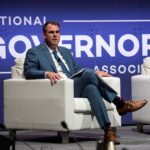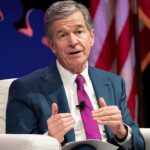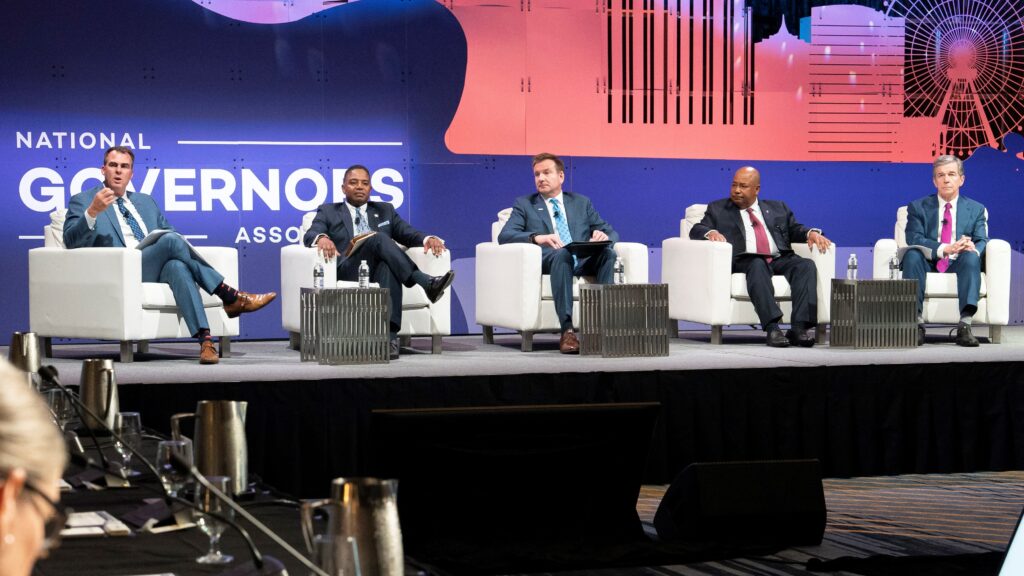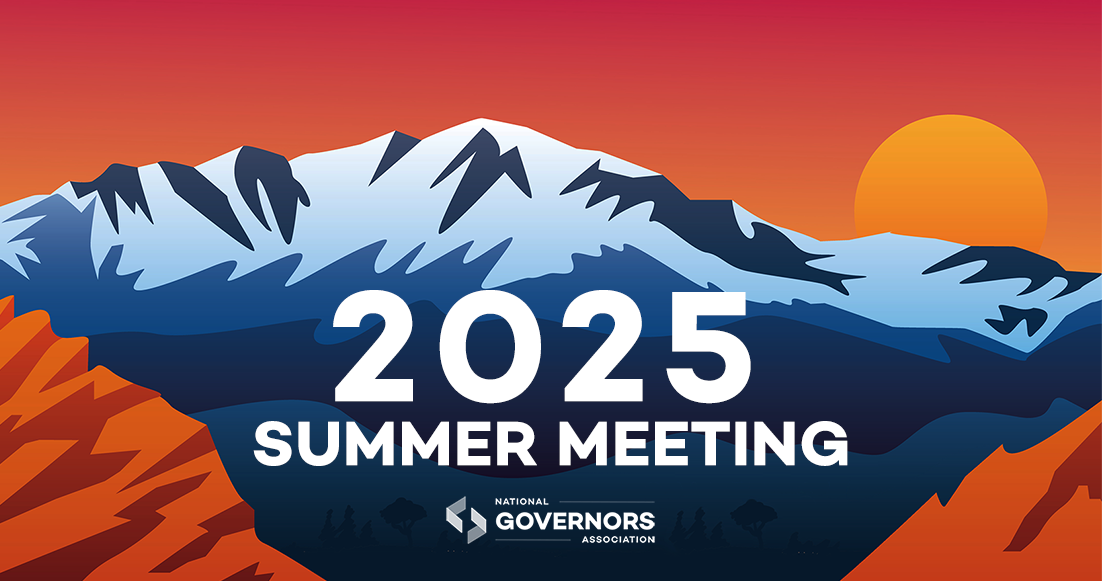Governors are working together across party lines and state lines on common sense solutions to safely speed up the process to deliver energy and infrastructure benefits nationwide. The enactment of the Infrastructure Investment and Jobs Act and the Inflation Reduction Act creates a historic opportunity to leverage the combined $1.4 trillion in energy, transportation, water and telecommunications funding to move forward on meaningful infrastructure projects.
Governors created a bipartisan Energy and Infrastructure Working Group in February 2023 to develop solutions to streamline permitting processes. The Working Group, co-chaired by Utah Governor Spencer Cox and Louisiana Governor John Bel Edwards, released a bipartisan vision of ways to accelerate project delivery – several tenets of which were incorporated into the debt ceiling agreement, the Fiscal Responsibility Act of 2023, recently passed by Congress and signed into law by the President in early June.
During NGA’s Annual Meeting in Atlantic City, N.J., Oklahoma Governor Kevin Stitt and North Carolina Governor Roy Cooper convened private sector infrastructure partners to explore permitting reform and other strategies to deploy funds and build infrastructure more quickly.

“The United States is among the slowest nations in the developed world in approving and completing infrastructure projects – particularly when it comes to energy,” stated Governor Stitt. “Permitting reforms approved in the recent debt ceiling legislation are a good start, but much more remains to be done.”
Noting Oklahoma’s position as both the No. 3 natural gas producer and No. 2 wind energy producer, Governor Stitt said, “Oklahoma’s energy story is an all-of-the-above energy story. We believe you have to have an all-of-the-above approach to have an affordable, reliable energy grid.” Yet energy stakeholders in the state have shared that it “takes 10 years to permit and 6 months to build” critical energy projects of all types.

Governor Cooper began his remarks by recognizing the importance of infrastructure – particularly high-speed internet – to business growth. “Right now, we have a generational opportunity to invest in infrastructure across this country,” Governor Cooper continued. “We’ve had plans before about what we needed to do. Now we actually have the funding to do it. [But] we have permitting challenges. There is a way to do all this: to protect our air and water, and to make sure permitting moves faster.”
A panel of industry leaders shared their experiences about the potential of infrastructure investment, as well as the challenges developers face in building infrastructure. Their excerpted comments follow.
Calvin Butler: President and CEO, Exelon
“When you talk about the transformation of the energy industry and the infrastructure needs of our country, we will undergo more change in the next 10 years than we have in the last 100.
“Exelon serves some of the most diverse metropolitan areas in the country, but we also serve coastal areas and rural areas. They have the same challenges and infrastructure needs, but how you address them is very different.
“We believe for the reliability and resiliency of the grid that it be an all-of-the-above approach, and it’s also important for the affordability factor.
“The ambition is there, but our actions are counterintuitive. We’re still operating on 20- 30- 40- year-old rules for today’s problems. Continuing to partner, collaborate, and break down siloes is critical to get this money to work and build up our communities.
“This transformation cannot be done without a qualified workforce. Workforce development programs and infrastructure academies that are being set up across the country [are] critical to ensure we have a talented workforce to move forward.”
Steve Woerner: President, New England, National Grid
“We are truly at an inflection point.
“Monumental volumes of clean energy systems need to be built to meet the energy goals of the [New England] region. We need to build an electric grid that’s two to three times bigger than today’s, [including] thousands of miles of new and upgraded distribution lines, substations, and more robust, secure communications network to identify issues and avoid disruptions to the economy.
“[There are] challenges around getting projects sited and built, challenges around the cost, securing the necessary supply chains and workforce, and acquiring property rights — just to name a few. Foundationally, we have challenges around agreeing on what it means to make an orderly transition to a cleaner, more affordable, and more just energy future. But if we work together, those decisions will be much easier.
“We have to move from a series of sequential approvals from multiple agencies to a process that is more streamlined, transparent and accessible to all.”
Tony Lewis: Regional Vice President, Verizon
“It is a shared opportunity to take advantage of [broadband funding]. Five-year plans need to be built in every state. Those plans can be dense, but they don’t have to be. We believe they can be simplified.
“Streamlining permitting is absolutely essential to get these networks built.
“Part of the problem we all encounter is forces of uncertainty: We have got to find ways to move from step 1, and then step 2, and then step 3. So often, we see the big problem and wring our hands and say ‘we’re going to have to do these 50 things’ — when there’s always a first step. I would encourage us to always look for that first opportunity, and that first opportunity can create momentum that’s necessary to start to move the project forward.
“What matters is that one person who finally gets broadband in Snow Hill, North Carolina, [and] building great broadband for people who need it most.”
During the session, Governors shared some of the challenges facing their states and discussed potential solutions with the panelists.

Utah Governor Spencer Cox
“We got some of the low-hanging fruit [regarding permitting reform]. We are going to get some sequential decision making, some shot clocks put in place to do that more quickly. But the endless litigation – a lot of what takes so long to move these projects forward is just litigation.”
Verizon’s Lewis added, “[Litigation] can slow this process to a crawl if we’re not careful. If we’re true partners, there are always solutions. But taking the first solution as litigation cannot be the way to ensure that the people who need this the most get it.”
Massachusetts Governor Maura Healey
“Building out these projects – whether it’s a more flexible, accommodating grid or anything related to additional clean energy construction – requires community buy-in. Do you have an approach to building out equitably? How can we think about good community engagement and buy-in that will help move things along and remove some of the friction?”
National Grid’s Woerner responded: “When we think about what projects need to be built, we also think about the community where it needs to be built. I firmly believe those who host infrastructure should benefit from it.” Woerner described the process for one project in Massachusetts and New Hampshire, which went “community by community, street by street” to engage with dozens of communities to explain the project’s benefits and earn local buy-in.
Puerto Rico Governor Pedro Pierluisi
“Puerto Rico is in the midst of an unprecedented reconstruction effort because of damage caused by Hurricane Maria. Right now, we have over 5,000 permanent construction projects underway. But the more critical ones relate to the energy system. Secretary Granholm and I are concerned about duplicative regulatory processes… What can we do as Governors to facilitate and expedite major projects?
“Hold us accountable to make sure we’re getting input from the communities and that the projects have considered those benefits,” replied Woerner. “But then work with us to make a decision and partner with us to move those projects forward.”
“Establish very clear expectations of what you want,” Butler added. “Be crystal clear about what you’re looking for from organizations that are going to come and invest and build. And then put a timeline around it. Then the companies who are able to step up to that challenge, will.”
Bringing the session to a close, Governor Cooper outlined the unique role Governors play in advancing infrastructure: “As we meet this challenge of infrastructure, there may not be a group more important in this country than the nation’s Governors are right now — because we have the opportunity to bring in the local governments, the private businesses, the federal government and the regulators to get this done. We have an unprecedented opportunity here, and it’s up to us to make sure it gets done efficiently, effectively, and as quickly as possible.”
Visit the NGA website to explore NGA’s infrastructure resources.












